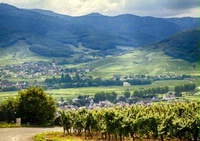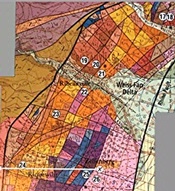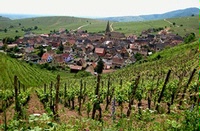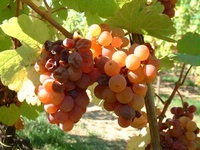|
|
 |

Despite producing a profusion of stellar wines, Alsace is often overlooked when it comes to French winegrowing areas. The wine press covers events in Burgundy, Bordeaux and Champagne with great alacrity, while Alsace is accorded a footnote. Although wine has been made here since Roman times, the tormented political history of the region has prevented Alsace wines from gaining the same recognition as other French producing regions. Between 1870 and 1970, Alsace was under German control more than French. The initial Alsace AOC was not established until 1962, decades after other French growing regions had codified their legal identity. There are some 4200 growers cultivating 15,600 hectares of vines in Alsace. Vineyard holdings are generally small and 80 percent of Alsace wines are still sold by négociants or cooperative wineries. Whether its lack of notoriety is due to fragmented vineyard holdings, political history or the sheer diversity of its wines, it’s time to rediscover the greatness of Alsace wine.

The Vosges Mountains Loom Over Alsace Vineyards
The vineyard area of Alsace is in northeastern corner of France at 47 to 49 degrees north latitude -- the equivalent of North Dakota on the North American continent. The fact that fine wine vineyards exist in this northerly clime is the result of marvelous natural coincidence. Geologic forces some 45 million years ago resulted in thousands of feet of downward drop of the broad rift valley through which the Rhine River now flows. The Vosges Mountains rise above the fault-dropped Rhine to the west and provide the basis for fine wine production. The complex geology left by these tectonic machinations has resulted in a byzantine patchwork of soil types that can vary tremendously over a very short distance. These changes profoundly affect the suitability of the ground for particular grape varieties. Thus, we have Gewurztraminer grown on the sandstone soils of the Kitterlé vineyard, profound Rieslings grown of the granitic soils of the Sommerberg, refined Sylvaners grown on the limestone of the Zotzenberg vineyard…and so on. While the Burgundian vineyard to the west is limited essentially to two grape types, the Alsace vignoble embraces arguably eight major varieties.

Geologic Map of the Vineyard Area Near Ribeauville
The vineyard area of Alsace is a narrow strip some 60 miles long but only about one mile wide. The vines grow at elevations between 500 and 1200 feet in the foothills of the Vosges Mountains. The sheltering effect of the Vosges provides a barrier against storms moving in from the west. Consequently, the average annual rainfall is lower here than in regions to the west and there is abundant sunshine during the growing season to allow slow ripening of the grapes in well-exposed vineyard sites. The mere turn of the slope in this northerly site, however, can change an excellent vineyard into a site where grapes simply will not ripen. The right exposure is crucial.

The Sommerberg Grand Cru on Granitic Soil above Niedermorschwihr
Consumers in the United States may find Alsace wines and labels easier to understand than most French wines. The Alsace tradition is to label a wine with the grape variety rather than a geographic location. Thus, one can find Gewurztraminer, Sylvaner, Pinot Blanc, Auxerrois, Riesling, Pinot Gris and other grape names on Alsace labels. There are now some 51 Grand Cru vineyards named throughout Alsace -- sites noted for high quality wines. Wines from these sites combine the grape variety with the geographic designation.
White varieties account for 90 percent of Alsace production. Pinot Noir constitutes the remaining 10 percent of the plantings and is used for the occasional red wine as well as rosés and Crémant d’Alsace, the noted sparkling wine of the region. Alsace wines, by law, are bottled in the distinctive tall, slender “Flûte d’Alsace.” Stylistically the wines tend to be dry, fragrant, richly-flavored, and backed by plenty of refreshing acidity. Domaine Zind-Humbrecht in Turckheim has led a successful recent trend among some producers to finish some of their wines with noticeable residual sugar. There is not always an easy way to know the style within the bottle, so knowing the producer becomes an essential part of knowing the wines. Riesling is considered the finest of the Alsace varietals and accounts for 22percent of vineyard plantings. Many of the Grands Crus of Alsace are planted to Riesling, but perhaps the most famous is Trimbach’s Clos Sainte Hune. From a small site in the village of Hunawihr, Clos Ste. Hune Riesling can grow and improve for decades.
Gewurztraminer is the region’s most aromatic grape. Effusive scents of ripe fruits, rose petal, lychee, and pine define a classic Alsace Gewurz. Pinot Gris (once known as Tokay d’Alsace) is lightly spicy and floral, with luscious apricot and peach fruits and earthy, truffle-like characteristics. Muscat is not as easily found in the market, since it can be finicky to grow and comprises less than 3 percent of the vineyard area, but it is worth seeking out for its unctuous texture and unique lime blossom bouquet. Pinot Blanc is made in a variety of styles, from crisp and refreshing to full-bodied and creamy. The peach-like fruit and earthy style of the Pinot Blanc grape, however, remains evident across the spectrum of wines.
Auxerrois is similar to Pinot Blanc but most often has more intensity and a velvety, creamy texture -- peaches and cream in a bottle! Sylvaner accounts for about 7 percent of vineyard plantings and, at its best, enchants the taster with flavors of the woodsy, floral and earthy tones. There are also small amounts of Chardonnay, Chasselas and Klevener de Heiligenstein scattered throughout the Alsace vineyards.
Alsace wines are very food friendly. Gastronomically, the Alsaciens produce more top chefs and have more starred restaurants than any other area of France. So, it would seem logical that the wines would rise to the same level of epicurean pleasure. Choosing a wine to pair with your Choucroute or fully ripened Munster cheese is a delicious challenge.
Sweet, dessert-styled wines are produced in the ripest years with the designations of Vendange Tardive and Selection des Grains Nobles (SGN). Vendange Tardive is equivalent to a German Spätlese or Auslese in ripeness, whereas SGN is comparable to the German Beerenaulese or Trockenbeerenaulese in ripeness and complexity. Vendange Tardive and SGN wines must be made from the 4 "noble" varieties -- Riesling, Gewurztraminer, Pinot Gris, and Muscat. Grapes picked for SGN wines are affected by botrytis, the same "noble rot" that affects the wines of Sauternes.

Botrytis Affected Gewurztraminer Grapes at Hugel & Fils in Riquewihr
If it’s been a while since you have investigated Alsace wines, you will likely be delighted at the range of bottlings that are currently available. The wines, in short, are well worth re-exploring. Considering their intensity of aroma and flavor as well as their easy compatibility with food, Alsace wines are among the best buys on the market.
|
 |
|